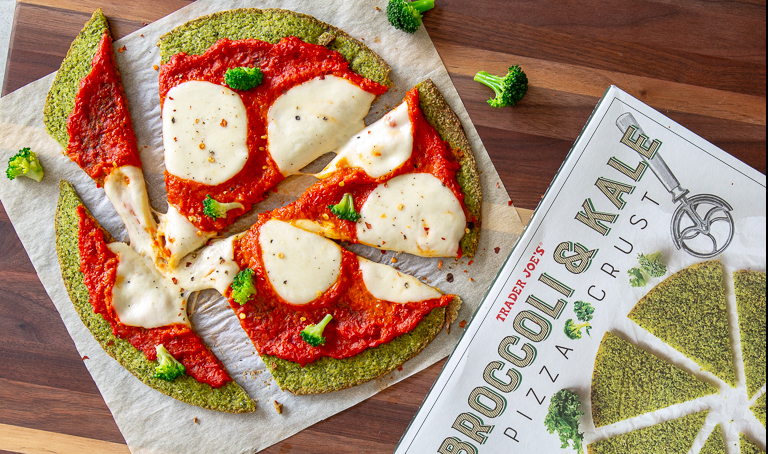Read on for the reason we don’t recommend this specific veggie-based crust (especially for those currently on a VLCD), and what to watch out for on ingredient labels.
According to US food labeling laws, ingredients must be listed in order of predominance; ingredients used in the greatest amount are listed first, followed in descending order by those in smaller amounts. Let’s use this ingredient list as an example:
BROCCOLI, CORN FLOUR, POTATO STARCH, CORNSTARCH, WATER, BLACK KALE, OLIVE OIL, SALT.
First up, broccoli! That’s great, right? For starters, we can’t be certain just how much broccoli goes into this crust. The crust weighs 10.3 ounces (420 calories for the entire crust). As one pound of raw broccoli is about 150 calories, we can safely assume the majority of the crust’s calories are coming from the corn flour (~440 calories per cup) and the potato starch (640 calories per cup; 40 calories per tablespoon). Also notable is the lack of fiber (0 grams per serving). If there were indeed a sizable amount of broccoli and kale in this crust (as the name of the product would suggest) you might assume it would contain more fiber. To compare, three ounces of raw broccoli contains ~2 grams of dietary fiber, and one cup of raw kale contains ~2.5 grams of dietary fiber.
Another important point is the lack of protein this pizza crust provides. For those on a VLCD, we stress the importance of getting enough dietary protein to preserve muscle mass, and coach our patients to build balanced meals around 200-300 calories. Let’s assume you have half of this pizza crust (which is actually fairly small), contributing 210 calories to your plate. You now have roughly 90 calories to play with, which isn’t much more than a light sprinkling of shredded mozzarella and some tomato sauce. But what about the protein? Three servings of this crust provides only 3 grams of protein.
So what to do if you’re wanting pizza, but are also being mindful of your ingredients and calories? There are options! We have seen people get very creative with (you guessed it!) our favorite low-carb tortillas. Bake in the oven to crisp up, add your toppings, and voila! High-fiber pizza coming your way. Another option is to make your own cauliflower crust, which allows you to decide what goes in. Last but not least, the best ready-made vegetable-based crust we have found is by Outer Aisles. These are on the pricey side, but are made with the least ingredients (cauliflower, eggs, Parmesan cheese, nutritional yeast, garlic, basil, and oregano) and contains a fair amount of protein. Each cauliflower pizza crust provides 120 calories and 10 grams of protein (this company also makes sandwich thins, which are 50 calories each with 4 grams of protein).
If you have any questions about a particular food, or are curious about something you see at the grocery store, don’t hesitate to ask your dietitian to review the ingredient label. We’re more than happy to learn with you!



